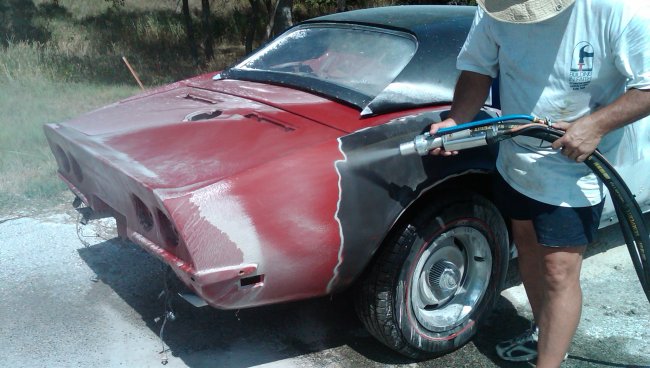on Facebook
"Full Inventory"
(Projects, Completions and Personal Collection)

77 Lancia Scorpion

67 Camaro RS Conv.
68 Austin Healey Sprite

68 Cougar

69 Corvette

70 Opel GT

69 Marcos 3000GT

86 TVR 280i

73 TVR 2500M

90 Buick Reatta

| Home | Current Inventory | Projects | Services | Company | Stuff | Bob's Car Collection | Contact Us |
|
on Facebook |
"Full Inventory" (Projects, Completions and Personal Collection) |
 77 Lancia Scorpion |
 67 Camaro RS Conv. |
|
68 Austin Healey Sprite |
 68 Cougar |
 69 Corvette |
 70 Opel GT |
 69 Marcos 3000GT |
 86 TVR 280i |
 73 TVR 2500M |
 90 Buick Reatta |
Prepare to Blast Off! | ||
 |
||
Sodablasting is a great way to strip almost any vehicle down to bare metal. It cuts through paint as fast - or faster - than just about any other process you might choose to use. Yet, it leaves the metal undamaged. In fact, on bodies that have never before been sanded, the metal is left with the original surface-tension boundary layer that it had when it left the foundry. This means that it will not flash-rust overnight as it might if it were sandblasted, sanded or stripped by any other means that etches the metal. And, for metal that has seen prior sanding, the soda residue left on the body helps to prevent flash rusting as well.
As great as sodablasting is, there are some considerations to keep in mind before you bring us your car or truck for sodablasting.
When the baking soda granules strike the surface, they disintegrate into particles so fine that they might as well be smoke. This means that soda residue will get into everything. Such as:
Do not expect any kind of tape masking or plastic sheeting to survive 200 cubic feet per minute of air & soda blasting out of the nozzle at 150 psi!
We also have the option of using our water-injection attachment when we blast your vehicle. This will help to chemically convert rust to more-or-less paintable surface. Injecting water into the blast stream significantly reduces the amount of dust/smoke residue. However, anywhere the soda collects, it will have to be removed as soon as possible or it will harden into a rock-like material that will take some effort to remove. We can rinse the body thoroughly and attempt to remove all the soda that collects in nooks and crannies, but we can't guarantee we can get it all. Also, if we rinse away all the soda dust, you'll want to etch prime the body ASAP to prevent flash rusting.
After sodablasting, the soda residue helps to ward off flash rusting for up to 6 weeks. But, it is imperative that you thoroughly rinse all the soda off the body before applying any paint products. Also, you will need to etch the metal with some sort of mild acid wash. Metal prep products are readily available at all automotive paint supply stores and through several other common sources. Failure to etch the metal can prevent paint products from forming a secure bond to the metal. So do not forget to etch!
We usually do our sheetmetal repairs before rinsing, etching or applying any kind of paint products on the sodablasted body. However, once all sheetmetal work is complete and after rinsing and acid-washing the body, we highly recommend applying a quality etching primer (such as PPG DPX171), or epoxy primer to ensure both a good bond to the metal and to enhance corrosion protection. Most high-build primers are not designed to be applied directly to metal. So, choosing your first product layer to apply over your freshly-stripped body is likely one of the most important paint preparation decisions you will make.
|
||
|
| |
| Send Mail to |
| bob@midlifeclassics.com |
| |